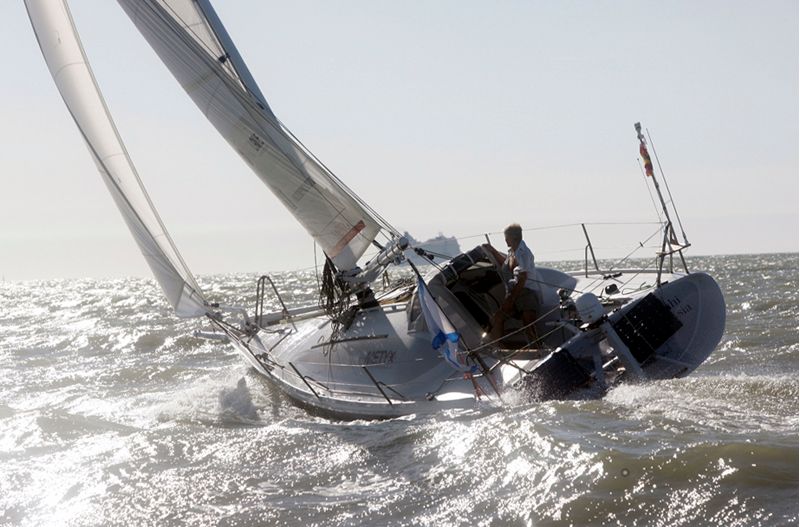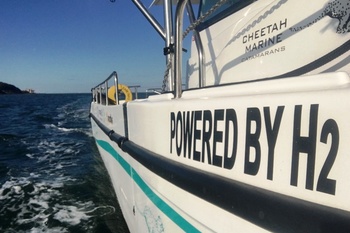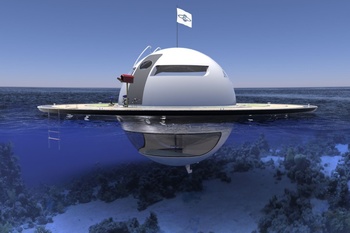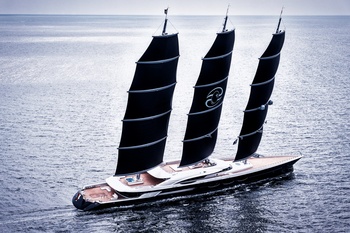On November 29, 2019 Yacht Russia magazine celebrated Viktor Yazykov with the award for the «best long-range sports trip» as part of the «Yachtsman of the Year»-2019. In March Yazykov completed his third non-stop voyage around the world on a boat built according to his own design and with his own hands. In this round-the-world trip he met his 70th birthday.

Viktor Yazykoff is a legend of sailing. He was a participant of Whitbread round the world and transatlantic race OSTAR, made his own operation in the middle of the ocean, designed and built an amazing boat, which is kept on course without autorail.
We collected everything we could find about this amazing character and his boats.
«Start sailing with the paddles.»
Viktor Yazykov was born in the village of Lazarevsky on the Black Sea coast. His father is a carpenter at the Lazarevsky Admiralty Shipyard, his mother is a teacher. As in almost every family of the village, the Lazykovs had a small boat-tuzik on which little Vitya not only fished, but also received the first lessons of maritime affairs.
His childhood suddenly ended just a few days before his 14th birthday. His father died in the stormy autumn sea: during another fishing trip, the dinghy was turned upside down by a wave. Victor remained the oldest man in the family. To help his mother put two younger brothers on their feet, he had to go to work at the shipyard. The young apprentice was sent to assemble yalls and other boats for the fleet, but he was also interested in yachts that were being built in the same shop.
When the first yachting circle was established in Lazarevsky, Viktor Yazykov was chosen as the headman. He got an opportunity to sail regularly on «Finn.»Together with the first independent (single!) voyages came the dream of a real, adult «boat» and long sea voyages. The decision matured quickly: to get the knowledge you need, you have to go to the sailor's department! And as the head of the family, Victor also helped his younger brothers to decide on the choice of profession. The average, Anatoly, also went on navigator, and the younger, Stanislav, became the engineer-shipbuilder. Later on, this very «family» brigade helped his elder brother to implement the most incredible projects.
Victor built his first boat (a tiny dinghy like his beloved «Finn»),»but the second one - a catamaran called «Colibri» - was created according «to real drawings. However, this little «bird» never had to fly on the waves for a long time: for unauthorized access to the open sea, she was arrested and finished her age on the roof of the border post.
«You want to learn how to sail, just hope to sail.»
By 1976 Viktor Yazykov managed to serve in the army, finish sailing, get a distribution in the Far East and grow from second to senior assistant captain of a fishing vessel. And at last he fulfilled his cherished dream - he got a diploma of a yacht captain!
His career in the fishing fleet was successful, but the gravity of the sails was stronger. A promising young XO suddenly went to work as a watchman at Nakhodka Yacht Club «Vodnik». Very soon he headed the yacht club. At first the whole Vodnik fleet «»consisted of three small boats, but already in 1978 the first yacht of sea class - «Argo»mono-coloured - appeared.
The old sloop required a major overhaul, so the energetic yacht club director had to remember his young years at the yard and roll up his sleeves to replace the stem, keel part and sheath itself. But the next year «Argo» under the command of Yazykov was the first boat to «open» Japan for Soviet yachtsmen.
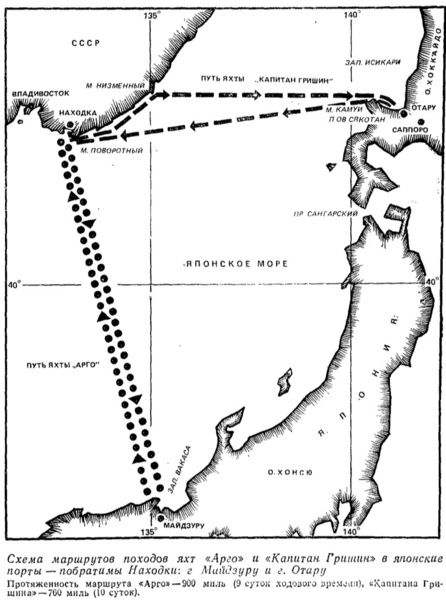

On the same sailboat in the following years Victor Arkadievich with a friendly team of like-minded people managed to sail along and across the Sea of Japan and Sea of Okhotsk, including a unique 2000-mile ice «»campaign to the Shantar Islands.
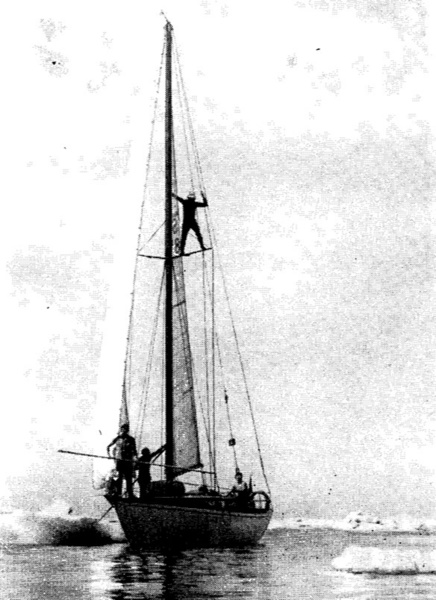
By early 1983 under the pennant of the Nakhodka Yacht Club there were already more than fifty boats, but by that time Viktor Yazykov had already stretched to the native shores of the Black Sea. Besides, now he believed that he knew what kind of yacht he needed and was absolutely sure that he could create it.
«It's best to build a boat at home and on your own.»
So, her name was «Laguna». The place of her birthplace was a playground under a light shed near the house of the Lazykovs. St. Petersburg designer Alexander Struzhulin helped to choose the basic project, but Viktor Arkadievich made significant changes to it. In particular, the keel was reinforced, the interior layout was changed, the safety margin was increased, and the entire structure was brought into strict compliance with Lloyd's rules.
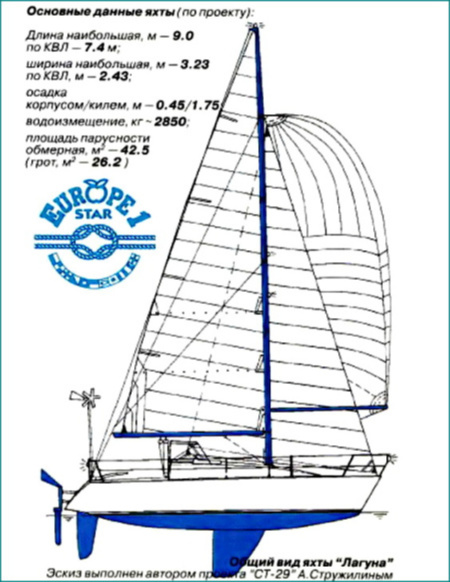
The body set was made of white oak, but an unusual type of wood - Caucasian chestnut - was used for lining. Languages made such an original decision after studying a mountain of literature on shipbuilding and consulting with local old people. It turned out that chestnut, which is abundant around Lazarevsky, can make a boat almost eternal - strong and light, it does not rot and is quite easy to handle.
Just to get the necessary amount of this valuable wood, Viktor Arkadievich had to settle down the surrounding mountains, choosing suitable trunks of already fallen trees (chestnut felling was strictly prohibited) and with great difficulty bringing them to his improvised «shipyard».
The construction of the boat was slow. There was a lack of money and the most necessary materials, and most of the work had to be done by Yazykov himself.
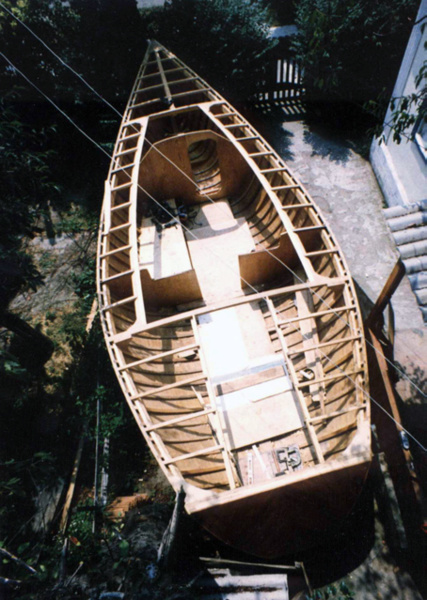
Besides, I had to take forced breaks. In 1986, Viktor Arkadievich worked for three months to eliminate the Chernobyl nuclear power plant accident («extra» radiation was leaving the body for almost six months). And in the late 80's he had the opportunity not only to help in the design and construction of the famous «Fazisi», but also to pass as part of its crew two first stages of the race Whitbread. By the way, tragically deceased skipper «Fazisi» - Alexey Grishchenko - Languages is still grateful for the valuable advice that allowed to make the «Lagoon» even stronger and more reliable.
And in 1991 he worked for a few months at the British shipyard «Carbospars», mastering the technology of manufacturing rankouts and hulls of yachts from carbon fiber. Here one of his English colleagues suggested him the idea of applying to the upcoming OSTAR-1992 Atlantic Single Singles Race. The incredible (at that time) company was unexpectedly successful: in a reply letter from the Royal Yacht Club Commander Mr.Jazykoff, he received an official invitation to participate in this prestigious competition.
It would seem that it was a small matter of driving «Laguna» to England, where she would be ready for the race. But deadlines were tightened, so the final work on the completion of the construction had to be in a hurry, and on the test of time is almost no left.
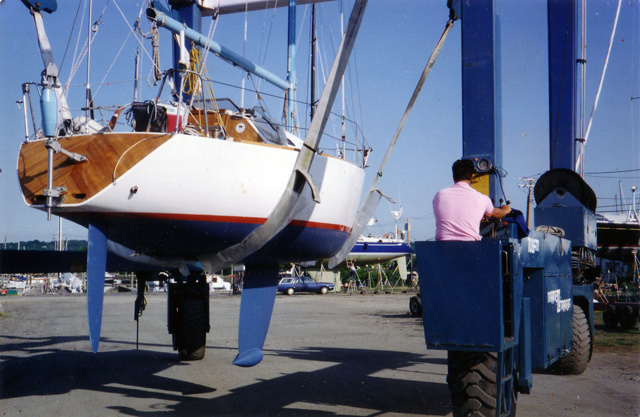
In addition, literally at the last moment there were procedural problems with releasing the «Lagoon» into the long distance. The USSR, which could not withstand perestroika, lived through the last days, but its borders were still on the castle. No agreement was reached with the border authorities in Sochi. Languages hoped to solve all the formalities in Odessa, but ... here the elements themselves intervened.
On the approach to the southern tip of the Crimea the yacht met the strongest counterstorm, so Victor Arkadievich decided to go directly to the Bosporus, where he honestly told the representative of the Soviet (still) consulate about the situation.
There was no turning back. The 9-meter «long Lagoon» was to be crossed for more than 100 days by the stormy autumn Mediterranean and North Atlantic. As usual - only under sails. No motor, no radio station. The only navigation equipment on board was a compass and an electronic lagoon. Of the four crew members, three went out on the open sea for the first time.
That's how the voyage started, which Languages himself later called «nightmare».
There was everything in it: the unseen force of a hurricane in the Mediterranean Sea, and towing on a tailwind wave at which the speed of the yacht reached 16-17(!) knots, and night differences with supertankers, which were carried literally in a few meters from a virtually invisible to them baby.
However, on December 21, 1991«, the Lagoon» was moored in Portsmouth Harbour, having passed the first exam of her life. The «home-built» boat went the hardest way from the rocky shores of the Caucasus to the chalk cliffs of the foggy Albion with almost no loss (except for the burst bakstag). It even withstood a temporary mast made of a pipe from an ordinary sprinkler system. Now the «Lagoon» was waiting for the transoceanic route.
«With the cards that Destiny gives us, we play ourselves...»
On June 7, 1992, the ninth OSTAR race started in Plymouth. The spectators were surprised to see few familiar white-blue-red flags on one of the boats. Are the Russians already here? Yes, they are - only instead of the more familiar to the eye red flag on the mast a new Russian tricolor, and on board a strange name: Laguna British Friendly.
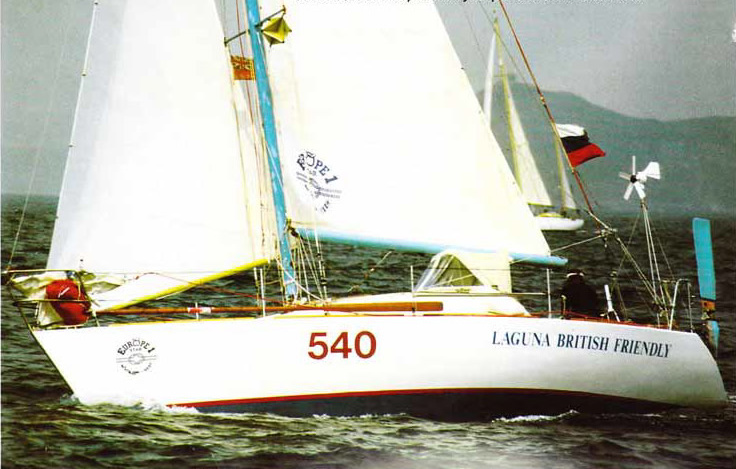
Viktor Yazykov added words of friendship with the British in gratitude for the help that the people of Foggy Albion have provided him in preparation for the transatlantic competition. Ongoing repair and cleaning of the hull, thruster and wind charger, food supply, and most importantly - invaluable moral support to the brave athlete who found himself in a foreign country without the help of his native state. Now all obstacles of domestic and formal character (including 500-mile qualifying single passage across the English Channel) are left behind. There's only the ocean ahead and... 74 rivals from 16 countries, each of which wants to win for sure.
Only 55 boats made it to the finish line that time. «The lagoon» finished 37th in the overall ranking and 4th (out of 16) in its class of 25-30 ft yachts. She crossed the Atlantic in just 27 days and 59 minutes - a pretty good result when you consider that OSTAR-I winner Francis Chichester in 1960 took 40 days and 12.5 hours!
And this time, Destiny brought a pleasant surprise to the brave traveller. He finished in Newport on July 4, during the US Independence Day celebrations. The brave Russian instantly turned into a hero of the American public, encouraged by the prospect of the close end of many years of «cold war». Viktor Yazykov was unanimously elected an honorary citizen of Newport, and more than 70 influential people, including several senators and the mayor of New York, signed an application for an entry visa for his wife.
»Viktor Arkadyevich tried to use his «American vacation to his best advantage. As once in England, he got a job at a yacht shipyard again, improving his knowledge and skills of working with carbon fiber.
Together with his American OSTAR racing colleague Robert Adams, Languages decided to build two identical boats for the Around Alone single round the world race. The company was given the symbolic name «Wind of Changes», and both yachts were to be built at the Russian shipyard. Alas, these plans could not be realized by the start of the 1994 singles races. On the other hand, more time was left to work out important details and a year later the project Wind of Changes was born - an original 40-feet boat with a rock«ing «ke»el», which at its rather modest size in terms of speed and navigability should not be inferior to 50-60 ft. analogues.
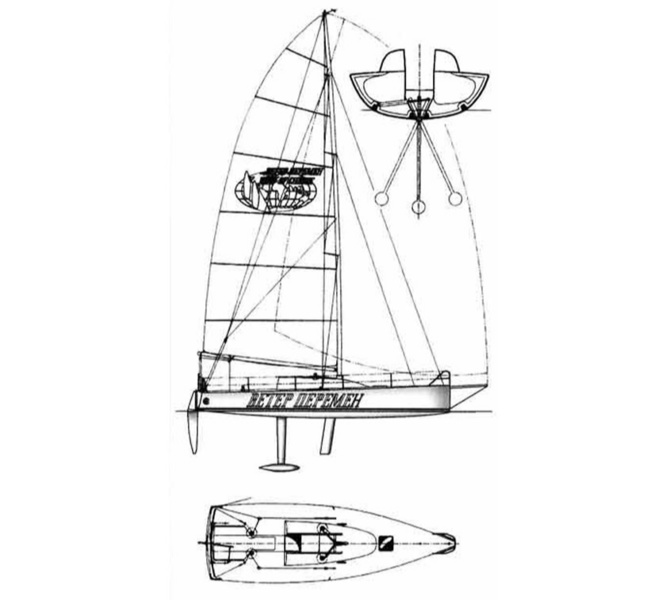
Scheme and main technical characteristics of a yacht «Wind of Changes»
Case material: carbon
fiberLength
of the
largest: 12.192
mLength by VL: 11,467 m Width
: 3,816 m Saddle
:
2,743 mDeposition
: 3,6
tSail
area
:
231,4 m2
In addition to the original keel (ballast weight 1,134 tons), additional stability and better handling of the boat provides a retractable centreboard at the bow. The yacht was designed especially for a round-the-world race, i.e. the stake was not so much on achieving high speed, but on keeping it as long as possible.
Taking into account the distribution of the most probable wind speeds on the upcoming route, the optimal sailing equipment was calculated: mainsail 76.2 m2 of staysail 37.2 m2 and spinnaker 118m2. A slightly larger mast height and bowsprit length than on traditional 40-foot boats made it possible to increase the mainsail area as well as (if necessary) the possibility to make a jib not overlapping it.
The construction of the yachts lasted three years and was not completed until early June 1998, with most of the construction of the carbon fibre hulls taking place. It took almost a month and a half more to prepare for sailing to faraway America. The subsequent voyage (more than 3,000 «mile warm-up» before round the world!) was a real challenge, especially in the final phase. The Winds of the Atlantic were so turned against both «Winds of Change»that the American skipper had to announce that he would not participate in the upcoming singles race. However, Viktor Yazykov did get to Charleston and 6(!) days after the official start of the competition (October 1) joined the Around Alone-98 with 271 hours of penalty time.
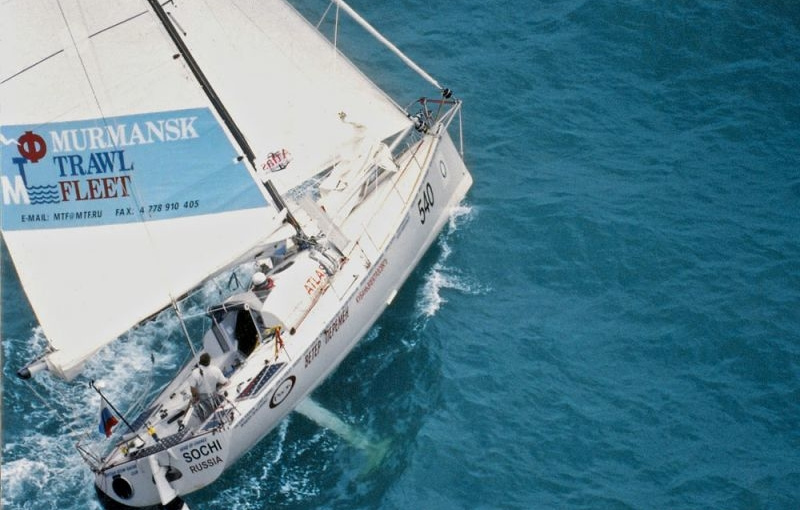
The results have surpassed all expectations: in just 44 days and 12 hours the Wind «of Changes» covered the distance from Chalston to the Cape of Good Hope, being the fastest of all 40 Ft yachts. During this time Victor Arkadievich had to experience twice the consequences of food poisoning (poor quality products failed) and make a real operation on his own by opening the boil on his right elbow.
The case turned out to be unique for both marine surgery and yachting: the operation had to take place in a rough sea, with the boat going at an average speed of 10-11 knots and a day passed a record for her 239 miles!
On day 15 of the second stage of the race, from the southern tip of Africa to New Zealand's Auckland, the «Wind of Changes» took fourth place in its class, outperforming even larger boats and nicknamed its captain «Flying Languages». At the same time on the recently operated hand of Victor Arkadievich acted only two fingers.
At the crossing from Auckland to the Uruguayan Punta del Este, our hero was again in trouble. The autopilot was out of order, sea water was leaking through the wiped hatch gasket into the stern compartments, and almost all fresh water supplies were lost due to damage to plastic canisters. Nevertheless, Yazykov retained fourth place in the subgroup, though he was so tired that he could not hold an already open bottle, which admirers presented to him at the finish.
At the final stage of the race, it was as if «Wind of Changes» had gained a second breath, and on the 21st day of the voyage it took third place in its class, which it had kept until the finish in Charleston on 18 May 1999. The total time of Viktor Yazykov's first round of the world was 168 days 10 hours 9 minutes and 44 seconds - and that's still taking into account the «penalty» 11 days and 7 hours, which, objectively speaking, he did not deserve...
«I was a racer and I stopped being one.»
Now the fame and awards fell on Victor Arkadievich in a continuous stream, on both sides of the Atlantic. The courageous Russian yachtsman became an absolute favourite of the press and received the Global Media Choice award. «Yachtsman of the month» according to Seahorse magazine and «Yachtsman of the Year» at the choice of the All-Russian Sailing Federation was also awarded the title «of Man of the Year» by the Russian Biographical Institute, and (finally) an honorary citizen of his native city (Sochi is almost 7 years behind Newport).
But have all the peaks been conquered? In the summer of 2000 «Wind of Change» comes second in the Open class 40 single transatlantic races, but his 52-year-old captain is already thinking of another boat - this time for the non-stop Vendée Globe.
City of Sochi's new Open 50 class yacht was designed by Owen Clark Design (which created the famous Kingfisher Helen MacArthur) and began construction in 2001 in Porto San Stefano, Italy. A year after the start of the construction of Languages was full of optimism about its fate, but... the works at the Italian shipyard progressed slowly, and their quality was not satisfactory to Victor Arkadievich.
Meanwhile, the sponsorship money was running out and it was becoming increasingly clear that it would not be possible to finish the yacht in Italy. In the summer of 2003 Languages made the final decision to move her to a home shipyard in Lazarevsky and successfully fulfilled his intention - and under a temporary mast! By the way, on a way (in Istanbul) it has met Evgeny Gvozdev, returning from the second round-the-world navigation, and has helped to tow it 3,7-meter «Said» through Black sea.
It is possible that the accidental meeting with this master of leisurely round-the-clock in tiny boats once again made Victor Arkadievich think seriously about the answer to the question: is it necessary to take part in races to know the sea and his possibilities in it?
Anyway, another non-stop race of singles on the route of «wool» clippers started without Viktor Yazykov. He prepares for quite different voyages and builds a new, perfect boat for them.
«The yacht is a living creature to be spoken in the same language.»
Early evening of May 26, 2007. An unusual boat slides along the blue Black Sea waves near Sochi. It as if does not notice the weight of 12 people gathered on it and easily keeps the speed of 5-6 knots even in low winds.
She has no auto-rudder, and at the helm not a soul - like the legendar»y Captain Slocum's «Spray, the yacht itself keeps the set course more accurately than the most experienced helmsman would do. But why be surprised? It's the «Daughter of the Wind!»

Sketch and basic specifications of the yacht «Daughter of the Wind»
Length: 10.5 mSize:
3.2 m
Size:
2.4 m
Size: 2.
75 tWeight
of
keel: 1.2 tSize
of
sailing
area
: 60м2
During almost four years of construction, Viktor Yazykov managed to embody not only the best features of all previous boats, but also the experience of ancient shipbuilders. The hull consists of several layers: in the middle of the lightest wood balsa (remember the unsinkable «Kon-Tiki» Tura Heyerdahl), on both sides covered with Caucasian walnut veneer (thanks, «Laguna!») Closes the same unique sandwich shell of carbon fiber, which proved itself so well in the «Wind of Changes», and later - and the City of Sochi. By the way, from the latter borrowed and technology to connect the body in diameter of two symmetrical halves.
The original design of the deckhouse and cockpit ensures that even if it is overturned, the superstructure will «not cling» to the water and the yacht will be able to return to normal position on its own. Only three hatches (one of which is light), as well as a ramming bulkhead in the bow and another hermetically sealed bulkhead on the midships, contribute to low waterlogging.
The mast is made of carbon plastic (the experience gained by Victor Arkadievich at shipyards in Britain and the USA influenced). It is a swivel wing with round base in cross-section and has no traditional standing rigging. By the way, its absence contributes to more effective use of wind force when sailing in a tank: it does not put sails on cables. The girder-girder is fastened to the mast base low enough and is equipped with rigid carbon rod extensions for easy operation.
The most sensational feature is that there is no autorail on «Daughter Wind».
The role of the bow thruster (e.g. for maneuvering in the harbour) is performed by a long wooden... paddle, which if necessary is installed in a special gate at the stern - after all, the motor on the yacht is also fundamentally not provided.
Amazing stability on the course is ensured by careful balancing of the yacht, with the possibility of shifting the center of sailing in the longitudinal plane. This is due to the significant (by 2 meters!) keel-to-aft movement relative to the mast, as well as the wide centreboard mounted in front of it. Together with the rudder pen, these elements work like fins and tail of fish, helping the boat to stay on virtually any course without human intervention.
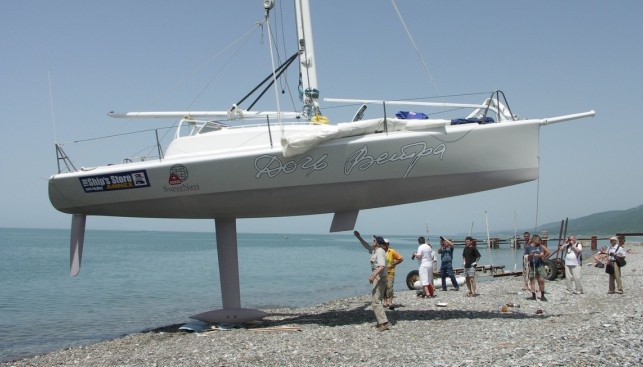
So «Daughter Wind» was conceived, designed and built as the perfect yacht for single trips. The first tests were successful, but... how will she behave on the high seas?
«Every new voyage should bring another discovery...»
This time Viktor Arkadievich is preparing for long-distance swimming particularly carefully. After all, preparation is 90% of success and one of its most important principles is not to leave a single chance to trouble.
Until the deep autumn of 2007, the Black Sea trials continue, as a result of which new improvements are made to the project. «Wind»'s daughter winters on the shore, gaining strength, because she has to walk many miles on the Black Sea, Aegean and Mediterranean Sea, and then cross the Atlantic twice (!). In 2008, with the ferry crew - from Gibraltar to Charleston, and a year later, only in the company of his tireless skipper - from the already familiar American Newport to English Southampton.
In addition to once again testing the remarkable qualities of a unique boat, the last passage has a more ambitious goal. On Daughter Wind»'s sails «the inscription Golden Globe-2010 appears with the route map of the famous race of the century. Without waiting for her official revival, Viktor Yazykov decides to sail solo non-stop, bypassing the capes of Good Hope, Lewin and Horn. At the same time, he intends to meet all the stringent conditions of the 42-year-old competition, including entry and exit from the English port.
Alas, it is impossible to realize this dream at once: the Wind»'s «daughter justifies all hopes placed on her, but Victor Arkadievich's health fails. The journey has to be interrupted in the Canary Islands, which for the next two years become the main base for a new attempt to make a round-the-world trip. For many months«, Daughter Wind» spends in the ocean, and in between, its creator tirelessly improves his favorite child.
Spring 2012: off to a full success again! In 199 days, Viktor Yazykov is sailing 28,000 miles around the world in four stages, without a motor or autorail. From the Canary Islands across the Atlantic, then passes the Panama Canal, crosses the Pacific, as well as the Indian Ocean and, after a short stop on the island of Mauritius, February 14, 2014 closes the circle around the globe in the Canary Islands.
This relatively leisurely journey is not a race for records, but a real attempt to understand ourselves and make sure that the world around us is created sensibly and correctly.
If Man is as intelligent as he is, nothing bad can happen to him, not even in the Ocean. Victor Arkadievich managed to brilliantly confirm this with his second round-the-world trip, and the Wind»'s «Daughter fully justified her nickname of a self-managed «sea-going SUV», providing her captain with a full opportunity to immerse herself in philosophical reflections while travelling.
But the main triumph for both of them was yet to come. On September 30, 2018 Viktor Yazykov left Tenerife on his extraordinary boat to make a single non-stop round the world, dedicated to the 50th anniversary of the 1968 Golden Globe race.
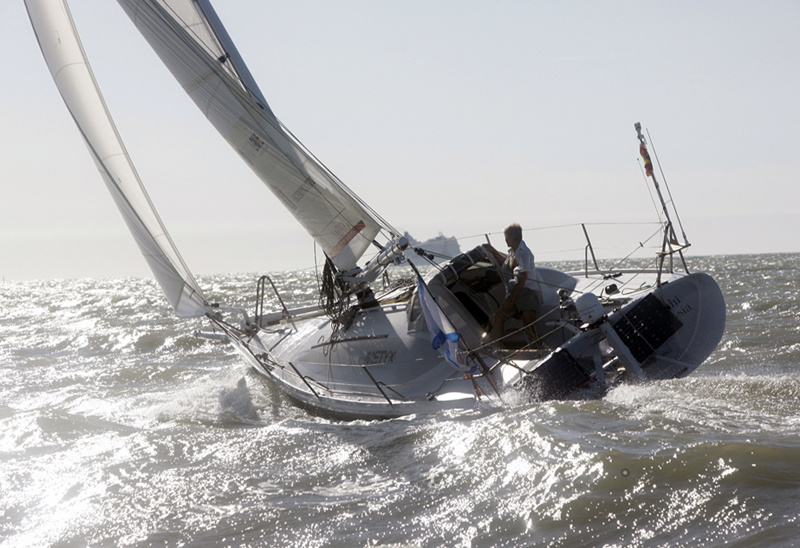
The non-stop voyage around three great capes lasted only 181 days. For comparison: the result of the official winner of the Golden Globe Race 2018/2019, the Frenchman Jean-Luc Van Den Hede was 211 days, 23 hours 12 minutes...
It should be noted that, unlike the participants of the anniversary race, as usual, it went fundamentally without a mechanical engine and no thrusters.
For six months the Wind» «Daughter had to overcome the bands of calm and withstand storms, but even in a 10-point storm, she steadily kept the course, allowing a single skipper if you want to spend up to 7 hours a day sleeping!
With no emergencies or more or less significant breakdowns. According to eyewitnesses who met the yacht at the pier of Las Gallegas on March 31, 2019, they were surprised to note her wonderful condition, as if she had not left more than 30 thousand difficult ocean miles behind the stern.
Victor Arkadievich himself looked great: healthy, cheerful and very cheerful, despite his long swimming and his very respectable age.
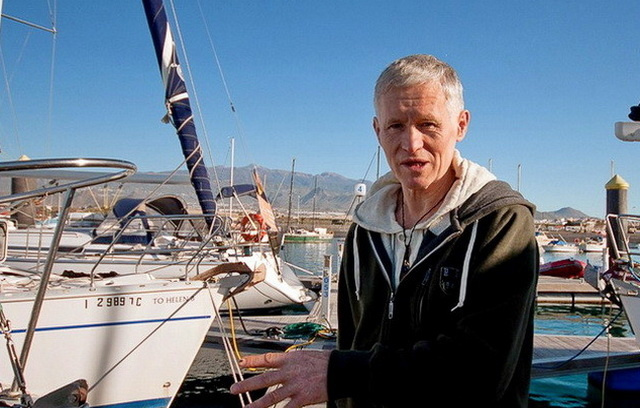
...And so, eight months later, the award found its hero. The recognized Yachtsman of Russia 2019 is preparing to meet a new year, 2020, in which we will certainly hear about his plans for new voyages, new philosophical discoveries in the relationship between Man and the Ocean, as well as about the projects of the new generation of boats that will bring true sailing enthusiasts the joy of true unity with the sea! After all, as Viktor Arkadyevich Yazykov states: The «result of the round-the-world is always the same. This is how much you've changed after going around the world, everything else is insignificant». And this simple truth is hard to disagree with...

